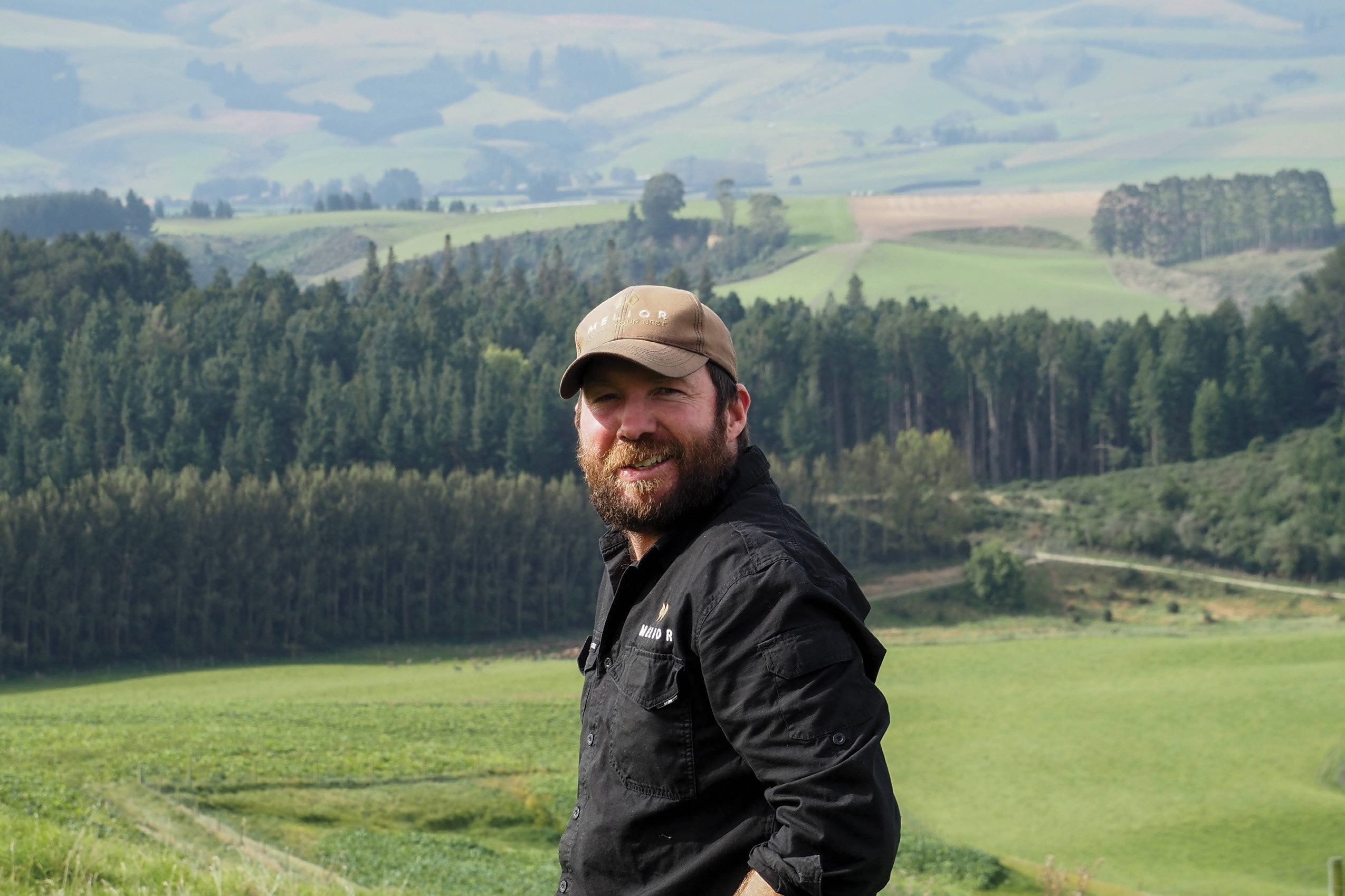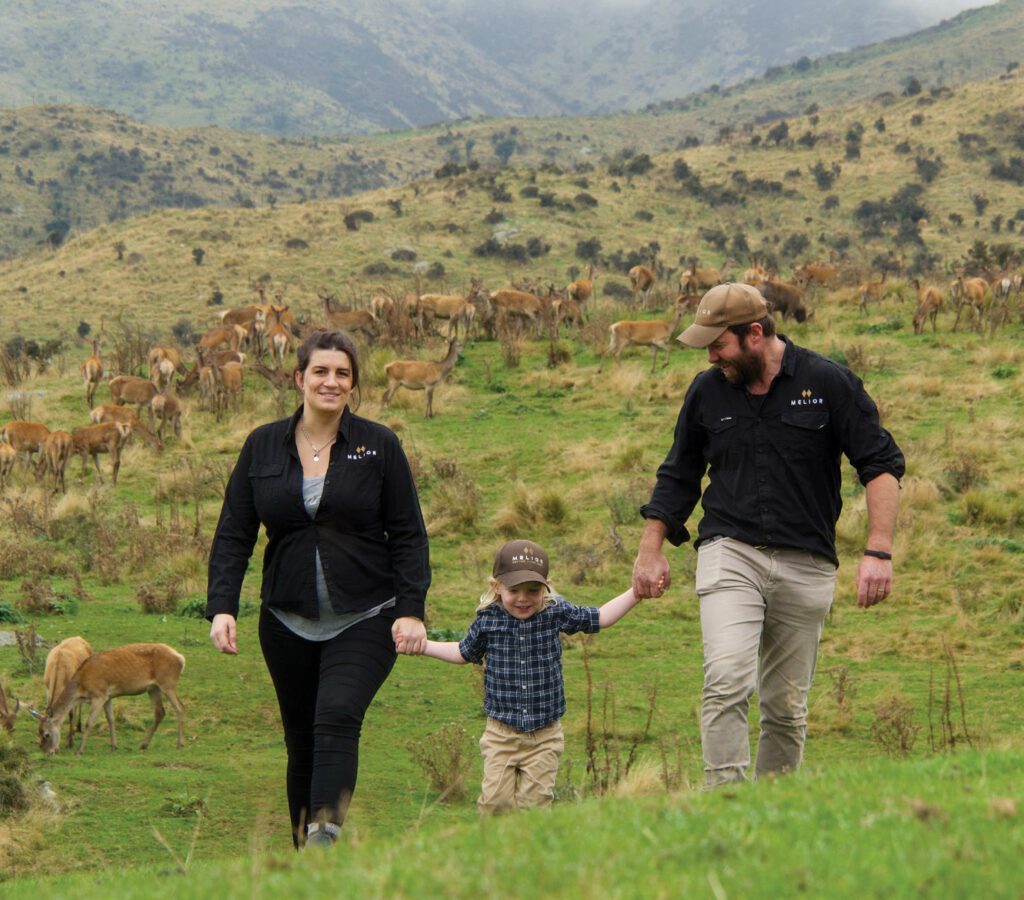Ringing the changes
A switch from dairy beef to an Angus herd makes a better fit with a South Canterbury operation’s primary venison system. By Lynda Gray. Photos by Anna Munro.

A switch from dairy beef to an Angus herd makes a better fit with a South Canterbury operation’s primary venison system. By Lynda Gray. Photos by Anna Munro.
Change is the only constant at Tom and Sam Macfarlane’s Melior Venison.
It’s not change for the sake of change so much as regular review and alterations to bring about constant improvement, which links in nicely with ‘Melior’, a Latin word meaning ‘better’.
A case in point is the swapping out of dairy bull beef for an Angus breeding cow herd over the past three years which has happened in line with developments across the wider farming enterprise.
From 2013 until 2019 the cattle side was based around the finishing of Friesian bulls at The Kowhais. The Macfarlanes developed the system to a peak throughput of 1000-1200 a year. Most were slaughtered before their second winter making a margin of about $800-$1000/head.
The bulls came through three channels; about 500 were bought at four days old and raised by Sam, another 500 were bought at 100kg. In addition to the bulls 150-200 18-month bulls of 400-450kg liveweight were bought in autumn, feed permitting, for wintering and slaughter in spring.

Dairy beef finishing was an efficient and profitable supporting act to the deer and lamb finishing, but in the long-term Tom could see that beef breeding cows and finishing would be a better fit with the deer.
“Bulls didn’t fit with the pasture demand from our other livestock classes and the system we were developing. The real problem time was in autumn because the bulls, hinds and weaners were all high priority feed-wise.”
Staying on the same track would add further cost to what was already an intensive system.
“We wanted to get away from buying in silage and growing lots of crop. As it was, we were growing 75ha of fodder beet, mostly for the bulls, and it wasn’t sustainable to keep doing that.”
Another driver for change was a couple of close calls with Mycoplasma bovis.
“We had three Notice of Directions over three years which was another reason to move away from dairy beef. We never went positive, but it caused a lot of disruption and uncertainty.”
The transition to beef breeding unfolded from 2019. The starting point was the end goal of breeding the best commercial cattle possible, which for the developing Melior system was a medium-framed cow that would utilise the second tier of feed, groom pastures for higher-profit young stock, and reliably turn out a calf with good growth and carcase potential.
Angus were the obvious choice because of the relatively handy Five Star feedlot end market option, and the Hargreave family’s Kakahu Angus the preferred supplier. Tom worked for Gerald and Sue Hargreaves during high school holidays and knows their son and daughter-in-law Tom and Anna. He likes their cattle breeding philosophy and stretched the budget as much as possible to start a Kakahu-based herd.
“I’m of the opinion that whatever livestock you’re dealing with it’s wise to start out with the best you can buy in terms of genetics so that you maximise the returns you get from feeding them.”
The best for the Macfarlanes’ budget were in-calf and carcase-scanned R2 heifers. They bought a total of 100 heifers over 2019 and 2020. Over the same time, they also bought 80 Angus-Hereford heifers with Kakahu bloodlines and mated them to an Angus. These 180 heifers formed the nucleus of the new breeding herd.
Angus bull purchases were mostly yearlings with good supporting data, which cost about half the price of a two-year-old bull. Last year $26,000 was paid for four bulls, of which three were yearlings.
Once-bred dairy beef heifers helped fund and reduce the capital outlay in the breeding cow herd.
In 2019, 80 dairy beef heifers that at one stage would have been bought in for beef were instead mated to an Angus. In December the calves were weaned, the heifers sent for slaughter and the income generated put towards buying the in-calf Angus heifers.
The breeding policy has evolved and is now relatively straightforward. All first-calving R2 heifers and pure Angus cows are mated to Kakahu Angus bulls, and the annual draft Angus-Hereford cows to Charolais bulls. Charolais became part of the beef equation for two reasons.
“At the outset I wanted a pure Angus herd and saw the best way to get there was to mate the R3s and older Angus Hereford cows to a terminal sire, but now with Stanton we’re using them there as well across the potential culls and annual draft cows.”
Choosing Charolais also saved money.
“I had to start my bull team from scratch and buying a large number of only Angus bulls at the outset would have been a huge outlay financially. I could buy what I deemed to be the best Charolais bull for a lot less than I could the best Angus bull.”
Taking on the lease of Stanton Station in June last year provided the opportunity to refocus the breeding and finishing sides of the deer, cattle and sheep operations. The rolling to steep hill and later growing country is ideal for hinds as well as cows and ewes, and by next year all but the first calving heifers will graze there.
“Stanton is at a steady state for now as far as cow numbers go, but that may alter as more deer go on.”
At weaning the calves go to The Kowhais and are priority fed according to their destined end market. Last year the first Angus steers went to the Five Star beef lot; it’s not always the highest paying market per head but it fits in well with feed supply and demand if cattle are moved before fawning.
“We know we can get rid of the steers before the autumn feed pressure comes on.
Rising two-year Charolais cross and Angus-Hereford cross steers grazing prairie grass and red clover at The Kowhais.
Last year we got half of them away in the second week of November at 470kg LW. We got $1400 for a 14-month animal which for us is a good return on the feed consumed.”
Aside from steers for finishing, The Kowhais grazes R1 heifers, R2 replacement heifers, as well as Angus and Angus-Hereford once-bred heifers. The number of cows and heifers will hover around 180-200, and the herd could be skewed towards younger animals.
“If we lift the number of first calvers and kill the surplus as once-bred heifers it will increase profitability and selection pressure.”

Transition complete
The transition from Friesian bull beef to beef breeding cows is complete and Tom is pleased with the end result.
The cows and progeny complement the wider Melior system in a way dairy bulls could not. They are valuable pasture control tools on the rolling and steeper hill country of The Kowhais. The young cattle work in particularly well with the weaner deer and lambs on the irrigated and lower lying pasture country.
“During spring we’ll put 100 steers in with 300 weaners. We’ll shift the deer but if the residual is still high we hold back the steers to graze down the pasture. It means the cattle get good quality feed and at the same time are grooming it for the weaners.”
Tom is the first to admit that side-lining dairy bull beef for beef breeding has left him worse off financially given existing beef returns but he doesn’t regret the move. It was the right move for the long term.
“You can’t look at different livestock categories in silos because it’s about how they work in together across the whole system and we wouldn’t optimise returns from the farm and keep making money from deer if we had stuck with dairy bulls.”
Looking back on the last three years he wouldn’t do a lot differently.
“We started out with a limited amount of capital upfront but have managed to establish a young herd with quality genetics.”
The change is bringing with it more beef cattle for finishing, raising the question of how best to fit them into the system.
“We’ve got to the stage where the Angus and Angus-Hereford steers are at weight for the feedlot pre-Xmas which is reducing feed demand in the autumn when weaner deer need it. But we’re now getting feed pressure from March to July with the increasing number of young Charolais cross cattle. We need to review and work out how best to fit them in.”
That review will no doubt mean tweaking, modifications and change – a process that’s become second nature to the Melior team.




